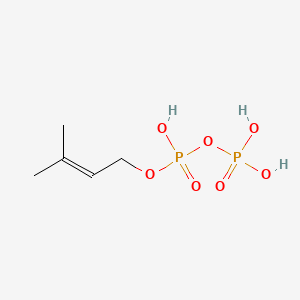| Sun Z et al. |
Can the capacity for isoprene emission acclimate to environmental modifications during autumn senescence in temperate deciduous tree species Populus tremula? |
2012 |
J. Plant Res. |
pmid:21584787
|
| Angaman DM et al. |
Precursor uptake assays and metabolic analyses in isolated tomato fruit chromoplasts. |
2012 |
Plant Methods |
pmid:22243738
|
| Wollinsky B et al. |
Breaking the regioselectivity of indole prenyltransferases: identification of regular C3-prenylated hexahydropyrrolo[2,3-b]indoles as side products of the regular C2-prenyltransferase FtmPT1. |
2012 |
Org. Biomol. Chem. |
pmid:23090579
|
| Nagel R et al. |
Nonradioactive assay for detecting isoprenyl diphosphate synthase activity in crude plant extracts using liquid chromatography coupled with tandem mass spectrometry. |
2012 |
Anal. Biochem. |
pmid:22266300
|
| Green SA et al. |
Identification, functional characterization, and regulation of the enzyme responsible for floral (E)-nerolidol biosynthesis in kiwifruit (Actinidia chinensis). |
2012 |
J. Exp. Bot. |
pmid:22162874
|
| Zhang YL and Li ZX |
Functional analysis and molecular docking identify two active short-chain prenyltransferases in the green peach aphid, Myzus persicae. |
2012 |
Arch. Insect Biochem. Physiol. |
pmid:22696503
|
| Faraldos JA et al. |
Probing the mechanism of 1,4-conjugate elimination reactions catalyzed by terpene synthases. |
2012 |
J. Am. Chem. Soc. |
pmid:23214943
|
| Dozier JK and Distefano MD |
An enzyme-coupled continuous fluorescence assay for farnesyl diphosphate synthases. |
2012 |
Anal. Biochem. |
pmid:22085443
|
| Aros D et al. |
Volatile emissions of scented Alstroemeria genotypes are dominated by terpenes, and a myrcene synthase gene is highly expressed in scented Alstroemeria flowers. |
2012 |
J. Exp. Bot. |
pmid:22268153
|
| Suzuki N et al. |
Construction and analysis of EST libraries of the trans-polyisoprene producing plant, Eucommia ulmoides Oliver. |
2012 |
Planta |
pmid:22729820
|
| Atsbaha Zebelo S et al. |
Chrysolina herbacea modulates terpenoid biosynthesis of Mentha aquatica L. |
2011 |
PLoS ONE |
pmid:21408066
|
| Zhong YJ et al. |
Functional characterization of various algal carotenoid ketolases reveals that ketolating zeaxanthin efficiently is essential for high production of astaxanthin in transgenic Arabidopsis. |
2011 |
J. Exp. Bot. |
pmid:21398427
|
| Du C et al. |
A mutation in the UBIAD1 gene in a Han Chinese family with Schnyder corneal dystrophy. |
2011 |
Mol. Vis. |
pmid:22065921
|
| Sun Y et al. |
Pyrosequencing of the Camptotheca acuminata transcriptome reveals putative genes involved in camptothecin biosynthesis and transport. |
2011 |
BMC Genomics |
pmid:22035094
|
| Baumeister S et al. |
Fosmidomycin uptake into Plasmodium and Babesia-infected erythrocytes is facilitated by parasite-induced new permeability pathways. |
2011 |
PLoS ONE |
pmid:21573242
|
| Gray DW et al. |
Biochemical characterization and homology modeling of methylbutenol synthase and implications for understanding hemiterpene synthase evolution in plants. |
2011 |
J. Biol. Chem. |
pmid:21504898
|
| Schmidt A et al. |
Induction of isoprenyl diphosphate synthases, plant hormones and defense signalling genes correlates with traumatic resin duct formation in Norway spruce (Picea abies). |
2011 |
Plant Mol. Biol. |
pmid:22002747
|
| Sui C et al. |
Transcriptome analysis of Bupleurum chinense focusing on genes involved in the biosynthesis of saikosaponins. |
2011 |
BMC Genomics |
pmid:22047182
|
| Lemuth K et al. |
Engineering of a plasmid-free Escherichia coli strain for improved in vivo biosynthesis of astaxanthin. |
2011 |
Microb. Cell Fact. |
pmid:21521516
|
| Zhou K et al. |
Novel reference genes for quantifying transcriptional responses of Escherichia coli to protein overexpression by quantitative PCR. |
2011 |
BMC Mol. Biol. |
pmid:21513543
|
